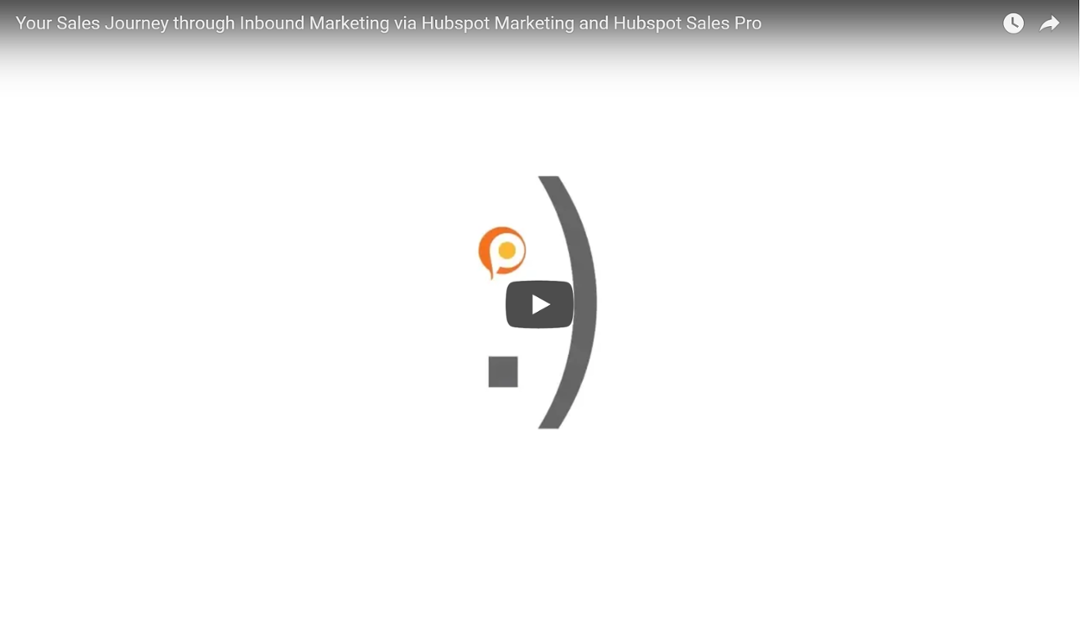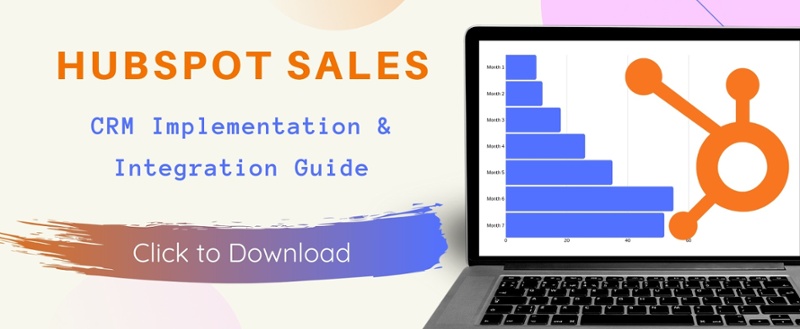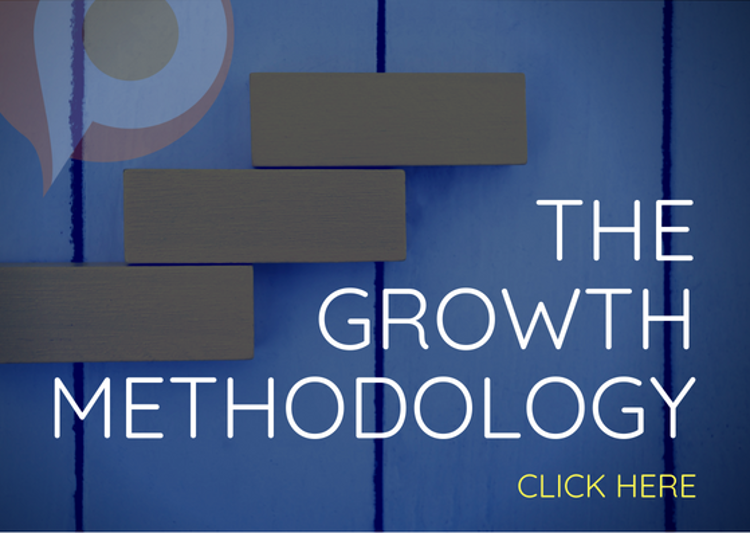Aim your business in the right direction.
When we're trying to bring a product or service offering to market, it's important that we go into the planning phase with a solid basis for what we are trying to accomplish.
As the owner of the business, this probably isn't news to you... But how aligned are your business objectives with the rest of your company's individual groups, particularly, sales and marketing?
I find it quite interesting how sales, marketing, and business objectives are so often separated into three different categories. Ultimately, aren't they all geared toward achieving growth?
Whether we're discussing keywords (SEO), social media, email nurturing, blogging, or even a big-picture inbound lead gen strategy, at the end of the day, I'm really just trying to find a path to increasing sales to help you achieve your growth goals.
To illustrate how they all play a role, I put together this video, which shows how a multitude of business objectives feed the ultimate goal of growth:
Now, let's talk about all of the little things that made this type of transaction (and the growth that follows) possible.
1. Absolute Objectivity in Decision-Making
There is nothing more acid-reflux-inducing than trying to course-correct or plan for the future based on data that is incomplete. While you continue to make investments in technologies and processes around servicing your clients, you're missing the boat big time if your sales people are still operating on an old-school CRM or none at all.
By "old school," I'm referring to 99% of the CRMs on the market today. Yes, even Salesforce is old school in the minds of those who have seen a truly modern CRM like Hubspot Sales.
How do you tell if your data integrity sucks? Ask your salespeople where they keep their most valuable information. Is it on an Excel spreadsheet, or is it in the CRM? Does the CRM automate data entry, thereby minimizing lost information? Is it easy to tell where the bottlenecks are in your sales process? As a business leader, can you tell where the strengths and weaknesses are with your sales teams by looking at a report?
Why not?
It's not a difficult thing to accomplish. You just need the right tools, and have it set up in a way that supports your sales process vs encumbers it. MOST CRMs add to the daily stress, not eliminate it. This is why they don't get used... why your most valuable sales data lives on Excel spreadsheets.
What sales data should live in your CRM?
ALL of it. Every call. Every email. Every appointment. Every. Single. Little. Detail.
With that kind of knowledge, you're sure to make much better decisions about staff, process, and strategy.
READ: How a Modern CRM will Improve Your Sales Outcomes
2. 5-minute (or less) Sales Response Time
My apologies for the heart palpitations you're sure to endure after sharing this information, but did you know that 50% of the deals awarded in the b2b environment go to the company that responds first?
HALF.
Did you also know that by responding to inquiries or any kind of engagement to your website or content within 5 minutes increases your salespeoples' chances of engaging in meaningful conversation by 2,000%!? That's a 20x difference!
My question to you: How long does it take for your sales people to reach out to a prospect when said prospect requests a call? ... or when they are visiting your pricing page? How about clicking a bottom-of-funnel email? ... or opening a sales deck?
Do they even have insights available to them like that in a live setting? ... or at all?
If the answer is no, or you're currently not even using a CRM, therefor at the mercy of isolated spreadsheets and god knows what else... Check out the Hubspot CRM. Here's a free implementation guide:
3. Remove your founder(s) from the day-to-day
This is a concept I am very familiar with. And, anybody who has started their company should be able to relate to a certain degree.
It's also likely the single most important transition your company will go through (at least until there's a completely new change in upper management).
Founders have an unusual ability to be good at just about everything in their company, because at one point, they had no other choice but to BE everything. And, while this is a strength and the difference between success or failure in the early years, it can be a real drag when it comes time to pushing off the ground floor and delegating to others.
I think this is an especially difficult task when it comes to sales & marketing. Up until this transition, THEY have been the brand. It's their personal connections that landed your company's first client, so their close rates were likely pretty high and didn't require a cool logo or website... or even "leads," for that matter.
The top reason why businesses going through this transition work with Orange Pegs is because we always start with infrastructure before scaling. It gives founders the ability to replicate their best qualities, and opens the doors for much more meaningful outcomes with whatever investments are made in sales and/or marketing. Then we follow it up by equipping sales with measurable collateral and processes. From there, we help generate inbound leads, and create rules of engagement/alignment between sales & marketing to ensure the most optimized sale possible.
4. Achieve Targeted Sales Predictability
There isn't a single business objective you can throw at me with any amount of significance that can succeed without sales. As my favorite investors on Shark Tank always say, "without sales, you're not a business."
But not all sales are equal, are they? Many of you are getting bogged down with "less than ideal" clients, because this is what comes your way.
By creating a lead generation engine utilizing the website, we are able to provide a steady, predictable flow of inbound leads that are highly targeted and engaged. Most leads don't close themselves, so we also help businesses by developing sales processes, onboarding sales teams, and creating harmony between marketing deliverables and the demands of business development.
With these two systems in place, founders are no longer solely responsible for generating and closing deals (a very time-consuming activity), which also means they can be removed from client contact altogether! Nobody expects Elon Musk to handle product issues, because he's not selling cars. He's busy growing the business in other ways.
- How does it fit with the rest of our portfolio? Can we leverage existing assets and knowledge, or will there be a significant investment required on our company's end to deliver?
- How demanding is the customer?
If you're out there offering services to everybody with a credit card, it's likely not going to resonate with a lot of people, so sales are going to be hard to come by. In addition, how does bringing in two completely different industries impact your delivery model?
We made the decision early on to specialize in software/SaaS (because they love inbound and are naturally attracted to our type of marketing) and professional services, particularly CPA firms, specialty tax firms, staffing agencies, and professional consulting.
We did this because at one point we had clients in freight transportation, taxi services, residential architecture, e-commerce, start-ups across MANY planes, and professional consulting. In that period, we discovered which industries complimented which, and the ones that were creating work that we weren't able to replicate ANYWHERE.
By removing the riff-raff, we have been able to secure better clients and deliver better results, because we became experts in those industries and were able to make better use of our resources.
I should also note that the type of marketing you deploy is going to make a difference in what types of businesses show up in your sales pipelines.
Inbound marketing, for example, is permission-based, and people are only becoming leads because they engage with your content - which, in the perfect inbound world, would be aimed specifically at your target industries and personas (what's a "persona?"). It also focuses on customer retention and turning your biggest fans into active 3rd party promoters of your brand.
So, not only does inbound help you attract good customers, but it also helps you make your existing customers better.
Although data warehousing has improved over the years, purchasing lead lists still tend take people off course.
Whereas outbound marketing and sales will often deploy technologies designed to sidestep privacy controls, which means your leads pile up quickly, but they're completely cold, so the likelihood of customer conversion is greatly diminished, and you also risk banishment from Google & friends as well as being blocked by spam filters.
In addition, you start your relationship with would-be GREAT customers by disrupting, which sets the tone for your future together. This could automatically put them on the defense and on the look-out for better, more convenient solutions.
So, think about lead conversion in context to your end-game. With a good inbound strategy, you can expect to convert 2 - 5% of your total website visitors into leads. Your landing pages, however, are more specialized, and you should expect lower traffic, but a much higher conversion rate of 15 - 20%.
5. Get a clear and effective brand message
"Branding" doesn't carry the same connotations as it did ten years ago. Planting company logos on billboards or pop-up ads were still the norm back then, and although there were no simple calculations as to how we could translate "impressions" into dollars and cents because it was a wearing down process that was impossible to fully track, it seemed to work.
But today is a different day. Branding is becoming a much more interactive process thanks to the proliferation of social media, which has really united sales and marketing into a more cohesive unit... well, when businesses allow for it anyway...
Okay... so maybe it's providing access to cohesiveness, and it's up to us to take advantage of it. What I see happening more often are sales people becoming their own brands by being active in social media while the businesses they work for either ignore it altogether or engage in it while ignoring the rules of social media conduct (using it as a platform for broadcast advertising, for example). They typically aren't aligned in this regard.
We have to let go of the notion that "impressions" are enough. In fact, we shouldn't even be focusing there first, because by doing so, you're very likely to engage in more black-hat, devious forms of marketing that leave a ton of impressions, sure, but they tend to be quite negative.
Your brand message comes across every channel you use to connect with the public. If you're spamming, your message is negative. If it's permission-based, well... it's quite the opposite.
6. Integrate Marketing with the Sales Process
Are you hoping your marketing will handle the entire sales process by opening interest AND closing the deal? I suppose it's possible, especially in a retail environment where it's actually desirable. But even retail has people on the sales floor, so why wouldn't your online experience offer something comparable?
This is an important part of incorporating the right marketing objectives into your planning. At what point does sales have visibility of your prospects, and when are they encouraged to taking that first step? Are they part of the original planning process that sets the rules? Because they absolutely should be. Yes, you should be there too, but let sales & marketing drive it.
As an inbound marketer, I believe in the power of lead scoring and automated sales alerts. We should be able to assign point values to behaviors and patterns, and develop accompanying thresholds for knowing when to make the first move. It's how we conserve energy and resources for the most probable opportunities, rather than wasting time with deals that never had a chance to begin with.
7. Post popular blog topics - not viral ones
Although I didn't want to get too granular with specific strategies, this is an important one to highlight, because it helps establish the proper mindset about developing better business objectives in general.
When we blog, we don't do it with the intention of going viral. This idea puts expectations completely out of whack. What good is 100,000 impressions if it's not generating viable leads?
I remember reading a blog once that had hundreds of thousands of impressions, and thousands of likes and shares - it was about how Netflix was poised to release a flop of a television series (it was infuriating, because the critic hadn't actually seen an episode... it was just a gut feeling). Somehow they were able to find a connection to it with their brand's message about 99% of the way through the article. I have no idea what that message was, and part of that is because I was so angry at the fluff I just read that I purposefully drove it out of my brain by banging my head on the wall.
Okay, maybe I didn't take it that far, but I was pretty upset. It was pure nonsense, and driven solely by the idea that going viral is the only thing that really matters.
Don't blog or brand or call or advertise or market for impressions. Educate. So what if you only get 10 hits in the first week? That blog is going to be there as long as you leave it up on your site. Google and friends index it, and it's going to show up in search queries for years to come. It addresses very specific pain, so it will find those seeking answers to said pain when it arises.
When you make your objectives evergreen, you can actually build off of your successes.
8. Lower your customer acquisition costs
A business is not a business without business. Clearly, this should be on the top of your list as to why you are engaging in a campaign, but there should also be some rationality behind it and a game plan to support it. Earlier I mentioned the importance of the hand-off between marketing and sales, but it's also about product and service delivery.
With inbound, you increase your odds of being found and closing the deal, but it's only part of the equation.
Your sales teams should also be active with social media (here's a great social selling forum they could join) and other lead prospective activities, and leverage the marketing to your marketing, not relying 100% on it.
You can significantly lower your customer acquisition costs through inbound marketing. Check out this collection of statistics compiled by MIT, proving that point.

Having the right objectives from the beginning will give you focus and a better chance at actually reaching your sales goals and utilizing the right b2b marketing solutions. They will align your expectations with reality, which will help you make choices that are going to positively impact your bottom line.
Check out how our growth stack can help you achieve your business objectives:




